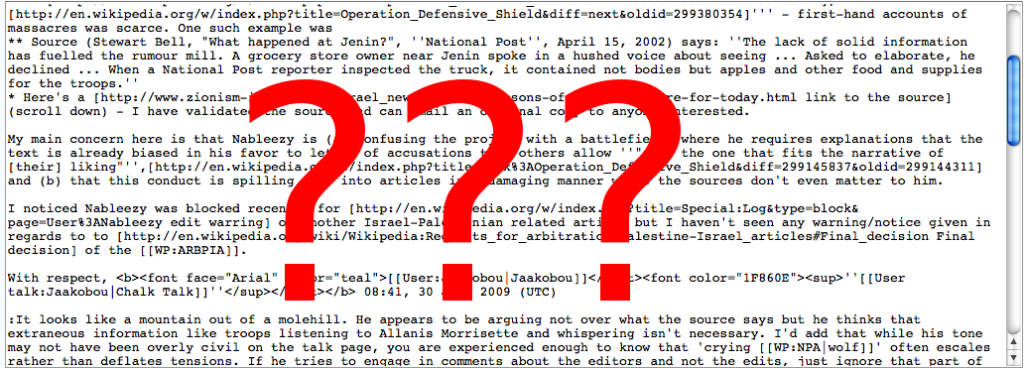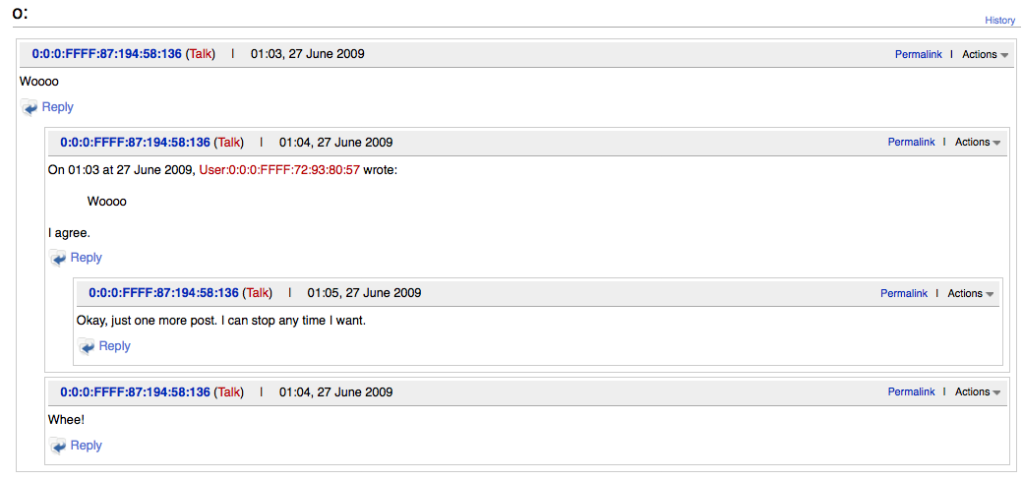Hi all,
Some of you might have already seen my blog posts about LiquidThreads, Wikimedia’s in-development discussion system.
For those who haven’t, this is a quick primer on what LiquidThreads is, and what it’s going to do for Wikimedia’s communities.
Currently, Wikimedia’s discussion system sucks. Here’s why:
- It’s not easily usable by the average user. It isn’t obvious how to leave a comment on a talk page, or how to reply to a comment. The indenting we use now is ad-hoc and unsustainable for long discussions.
- Signatures are done manually and we have to jump on poor unsuspecting newbies who don’t know this (or write bots…)
- Archiving is done unevenly by bots, which are maintained by users and therefore of very uneven quality. Archives are something of a black hole — they aren’t searchable, easily maintainable or easily accessible. You can’t resurrect an archived discussion easily, nor can you view its history.
- It’s stored as plain wikitext, which is opaque to any sort of automated process.
- You can’t move a thread to a different discussion page and preserve its history.
- There’s no encouragement, mechanism or incentive for quoted, point by point inline replies like we’re all used to with e-mail.

Enter LiquidThreads. LiquidThreads is a system that makes MediaWiki’s discussion system behave like a forum or comments thread, while still maintaining the unique refinements that make wikis work. It was originally designed by a Google Summer of Code student, David McCabe, and I’ve been making incremental improvements to make it work for Wikimedia.

So, what’s changed?
- Comments are separated from each other in the wikitext, so there are no more edit conflicts in discussions, and the usability is vastly improved.
- Instead of indenting, each comment is in its own box, along with its replies. It makes it much easier to follow each post and its replies, and it’s much nicer on the horizontal whitespace. Hopefully, it will be the death of the ‘arbitrary section break’!
- Each post has its own history page, making it easy to see what’s going on with individual threads without trying to navigate the history of a whole page.
- It’s easy to move threads between pages, preserving the page history.
- Discussions are never ‘archived’. Instead, older discussions fall to the bottom of the page, and eventually they drop off entirely, to hit a new page. If you missed the chance to have your say, just reply to a discussion and it’ll be bumped right up to the top of the page again!
- Discussions with recent changes are at the top of the page. Discussions that have fallen dormant fall to the bottom. It’s easy to find out what’s happening!
- You can watch individual threads of a discussion, and even get an email when they’re replied to.
- It’s easy to link to a discussion, and the links are permanent unless the discussion is deleted. There’s no need to point to an archive or to an old revision ID.
If you’re interested, I’ve put together a test setup for you to play with it.
Andrew Garrett, Editing & Discussion Features Development Contractor
As always, questions, comments and suggestions are more than welcome, in the comments or elsewhere.

Can you help us translate this article?
In order for this article to reach as many people as possible we would like your help. Can you translate this article to get the message out?
Start translation